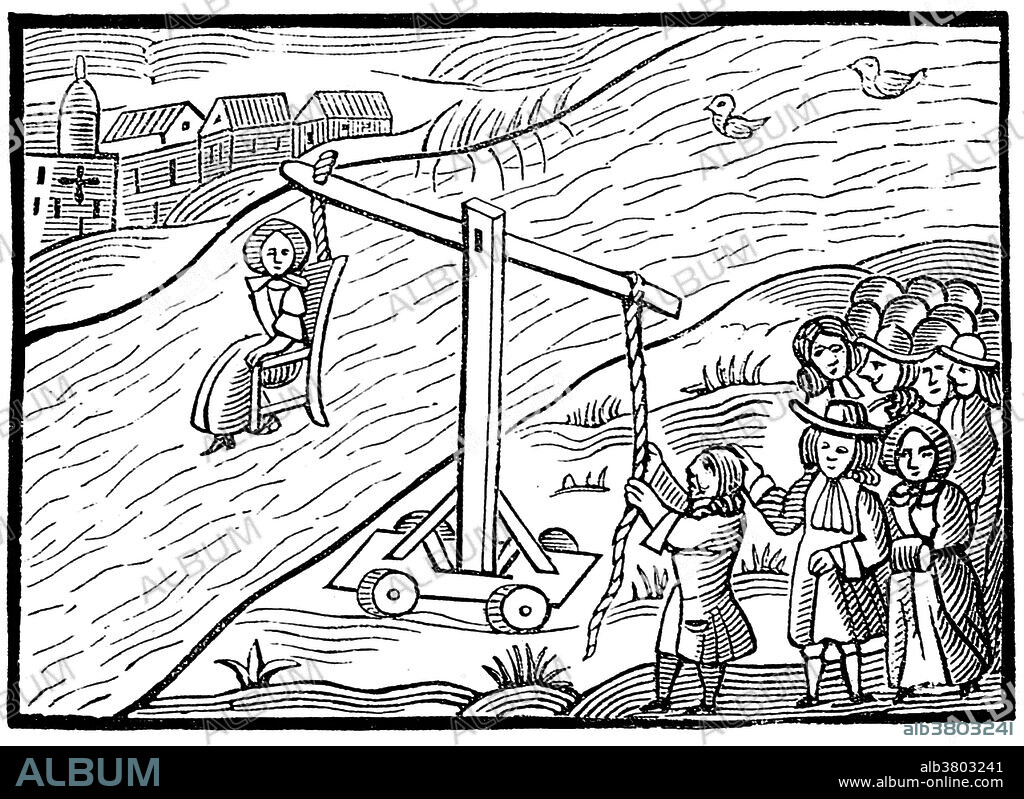alb3803241
Public Humiliation, Ducking Stool

|
Add to another lightbox |
|
Add to another lightbox |



Buy this image.
Select the use:

Title:
Public Humiliation, Ducking Stool
Caption:
Cucking stools or ducking stools were chairs formerly used for punishment of disorderly women, scolds, and dishonest tradesmen. An instrument of public humiliation and censure. The ducking-stool was a strongly made wooden armchair in which the offender was seated, an iron band being placed around her so that she should not fall out during her immersion. The earliest record of the use of such is towards the beginning of the 17th century, with the term being first attested in English in 1597. Usually the chair was fastened to a long wooden beam fixed as a seesaw on the edge of a pond or river. Sometimes, however, the ducking-stool was not a fixture but was mounted on a pair of wooden wheels so that it could be wheeled through the streets, and at the river-edge was hung by a chain from the end of a beam. In sentencing a woman the magistrates ordered the number of duckings she should have. Another type of ducking-stool was called a tumbrel. It was a chair on two wheels with two long shafts fixed to the axles. This was pushed into the pond and then the shafts released, tipping the chair up backwards. Sometimes the punishment proved fatal and the victim died of shock.
Credit:
Album / NYPL/Science Source
Releases:
Model: No - Property: No
Rights questions?
Rights questions?
Image size:
4350 x 3167 px | 39.4 MB
Print size:
36.8 x 26.8 cm | 14.5 x 10.6 in (300 dpi)
Keywords:
16 16TH XVI XVITH SIXTEENTH CENTURY • 16 CENTURY • 16TH CENTURY • 16TH • 17TH CENTURY • ARM CHAIR • ART • ARTWORK • BW • CENSURE • CHAIR • CRIMINAL JUSTICE • CRUEL • CRUELTY • DRAWING • DUCKING STOOL • DUCKING-STOOL • FEMALE • HISTORIC • HISTORICAL • HISTORY • ILLUSTRATION • ILLUSTRATIONS • INFAMOUS • INHUMANE • INHUMANITY • INTERROGATE • INTERROGATION • JUSTICE SYSTEM • LEGAL SYSTEM • LEGAL • MEN • ORDEAL BY WATER • PAIN • PENAL SYSTEM • PEOPLE • PERSECUTE • PERSECUTING • PERSECUTION • PHYSICAL PAIN • PRISONER • PUBLIC HUMILIATION • PUNISH • PUNISHING • PUNISHMENT • PURSUIT • SUFFER • SUFFERING • TORMENT • TORMENTING • TORTURE DEVICE • TORTURE INSTRUMENT • TORTURE METHOD • TORTURE • TORTURER • TORTURING • TUMBREL • VICTIM • VICTIMS • WATER TORTURE • WOMAN • WOMEN • XVI CENTURY
 Pinterest
Pinterest Twitter
Twitter Facebook
Facebook Copy link
Copy link Email
Email
